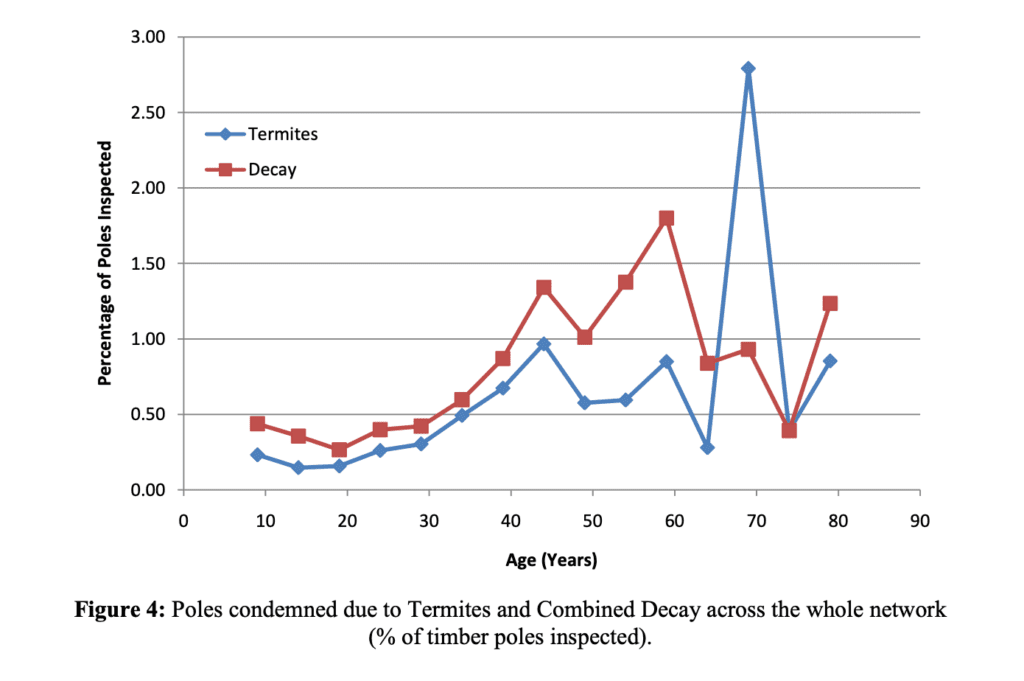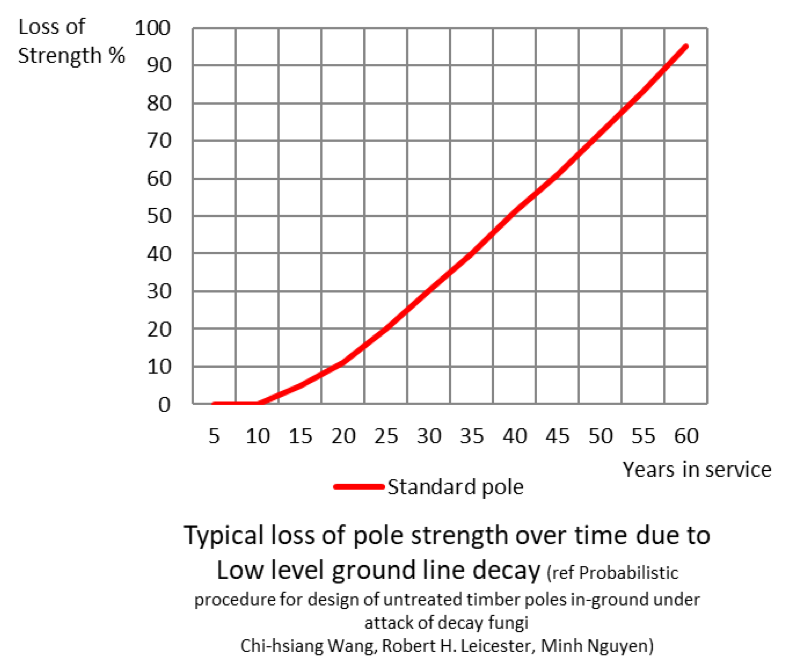Termite attack of wooden utility poles can be a severe problem when the right conditions exist for termites to thrive. Termites can do a lot of damage to wooden poles very quickly, and this nearly always cause pole failure.
The most effective way of inhibiting attack is by using multiple methods of prevention together, including chemical treatments and barriers. While it is not possible to remove all chances of attack, it is possible to reduce the likelihood of an attack significantly. This report looks at the conditions required for an attack to occur, evaluates the current methods used to prevent an attack and the benefits offered by full barrier sleeves as a means of reducing the likelihood of termite attack occurring.
Wood is a food source for termites, and where the right conditions exist, termites can consume large parts of a utility pole and weaken it in a relatively short period of time.
It is well known that termites are attracted to and have a much higher tendency to attack decaying wood in ground contact. “Fungus infected wood is highly susceptible to termite attack when compared to sound wood” Ref Matsuo, H. and K. Nishimoto. 1973. This attraction is because wood-decaying fungi break down the wood making it more digestible for termites, thus increasing the nutritional value of the wood for the termites.
Independent research shows that “Representatives of all the classes of fungi are associated with termites. Slight deterioration of wood by certain Basidiomycetes of the brown-rot type also increases its nutritional value to termites (Light and Weesner, 1947; Becker, 1948, 1965).
The correlation between the occurrence of wood decay in utility poles and attack by termites is also confirmed by independent research in Australia. (source: Pole Service Life – An Analysis of Country Energy Data, Nathan Spencer Koppers Wood Products Pty. Ltd., Sydney, Australia, Leith Elder Country Energy, Goulburn, Australia).
The graph below is taken from his report below shows a clear correlation between the occurrence of wood decay and termite attack in treated wooden utility poles (C.C.A. treated Eucalyptus poles).

As can be seen from the graph above, termite attack rates increase over the life of the pole in almost direct relation to the incidence of wood decay in the pole.
To protect utility poles from fungal decay, many utility companies will use a wood preservative treatment process. Wood preservatives provide a high degree of protection (toxic and repellent effect) to termite attack. It is also well known that creosote and C.C.A. type wood preservatives are very effective at preventing termite attack of a utility pole, however, over time the effectiveness of wood preservative is reduced by leaching, oxidation and loss of water repellence.
This effect is most pronounced at the ground-line section of the pole where exposure to air and frequent wetting and drying cycles occur. Once the effectiveness of the preservative is reduced, the resistance to attack by wood-decaying fungi and termites deteriorates.
This loss of protection over time is variable and depends on climate, ground conditions and other factors, and increases over time. The graph below shows typical loss of pole strength over-time for a pole used in the Northern Hemisphere. (The lifespan and time for onset of decay/loss of strength are generally around half the values shown for poles used in the southern hemisphere.)

Firstly, Full barrier sleeve material has been subject to independent testing using A.W.P.A. E1-97: 2005 (American Wood-Protection Association): 2005.’ The standard method for laboratory evaluation to determine resistance to subterranean termites. In a no-choice and two-choice test, the samples protected with full barrier sleeve material were not attacked by the termites. (Full test report available on request)
Secondly, as has been previously discussed, there is a direct correlation between the onset of pole decay and the likelihood of termite attack of wooden utility poles. Thus, preventing decay at the vulnerable ground line section of the pole where conditions are ideal – meaning that the likelihood of termite attack will reduce significantly.
Full barrier (Polesaver) sleeves applied to the vulnerable ground line section of the pole;
The likelihood of termites attacking a treated wooden utility pole is closely related to the onset of wood decay, meaning that preventing wood decay in the pole significantly reduces the possibility of termite attack.
Decay in wooden utility poles occurs at the ground-line section of the pole where conditions for decay are ideal. However, full ground-line barrier sleeves like Polesaver make conventional ground-line decay impossible and prevent the loss of toxic/termite repellent wood preservatives. Independent testing also shows that they prevent direct termite attack.
By preventing decay, full barrier (Polesaver) sleeves can significantly reduce the likelihood of termite attack in wooden utility poles.



This site is protected by reCAPTCHA and the Google Privacy Policy and Terms of Service apply.